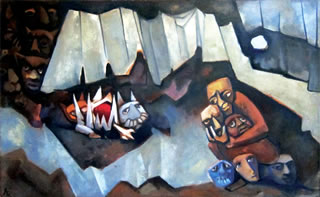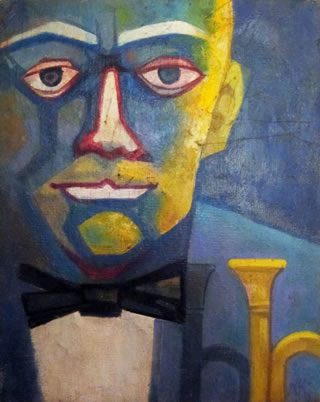Sacred Art - Page 6
 |
 |
|
|
|
|
Later they taught at Verde School in Arizona. The family moved to an artists’ colony, San Miguel de Allende in Mexico, intending to study with painter David Siqueiros, but returned to America when their daughters fell seriously ill. They settled in Marin after two years in Fresno, where Rice taught at Fresno State.
In Mendocino, Rice grew increasingly active in local issues, many of them environmental—ocean protection, water management, clear-cutting of the forests.
Urged to run for the county Board of Supervisors, he considered it. But, Felicia says, “All his life he had seen pictures in his mind. As he got more politically involved, he said he stopped seeing them. That was a sacrifice he was not willing to make.”
Between 1965 and 1983 those pictures in Rice’s mind became pictures on acetate, as he sat in a tiny, shack-like studio behind his tiny house inking acetate film to create between 30 and 40 films, most between three and 12 minutes, he described as “intentionally low tech. I tried to turn back history, to work from the primal.”
“He did them live,” Tepper said. “He sat there and he would paint something, do a frame, shoot it, do the next one, painstakingly. It was something he could do all by himself, controlling the whole thing. I think it was very pleasurable for him to do it.”
“You work very fast,” Rice wrote. “If you want to change your mind, you just do it, and you have complete control over it.”
The films are like his paintings come to life. It’s notable, perhaps, that Rice was slender and strong, but the figures in his films and paintings tend to be stout.
His techniques were varied. The films included live-action footage of goats, Big River, cemeteries. He worked in Claymation, filmed sculptures and other three-dimensional objects, and created and then filmed Japanese-style painted scrolls. The films are darker and far more grotesque than his better-known mosaic work and touched with strange humor.
“I’m intrigued by the fine line between the rational, the irrational,” he wrote, “…and the contrast and similarity between scientific knowledge and facts and fantasy.”
For sound, Rice would read his poetry, or play the viola de gamba. For the quasi-psychedelic, color-saturated Still Life, which suggests the ravages of war and perhaps the collapse of civilization, Rice moaned about “oatmeal...oatmeal,” and cackled like a chicken.




